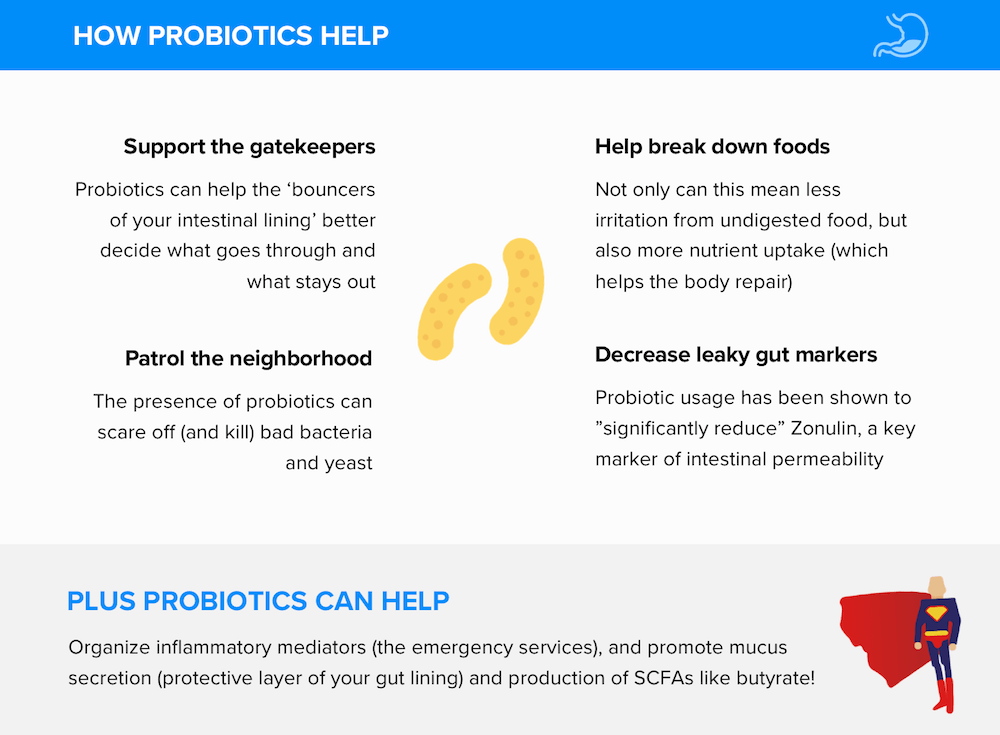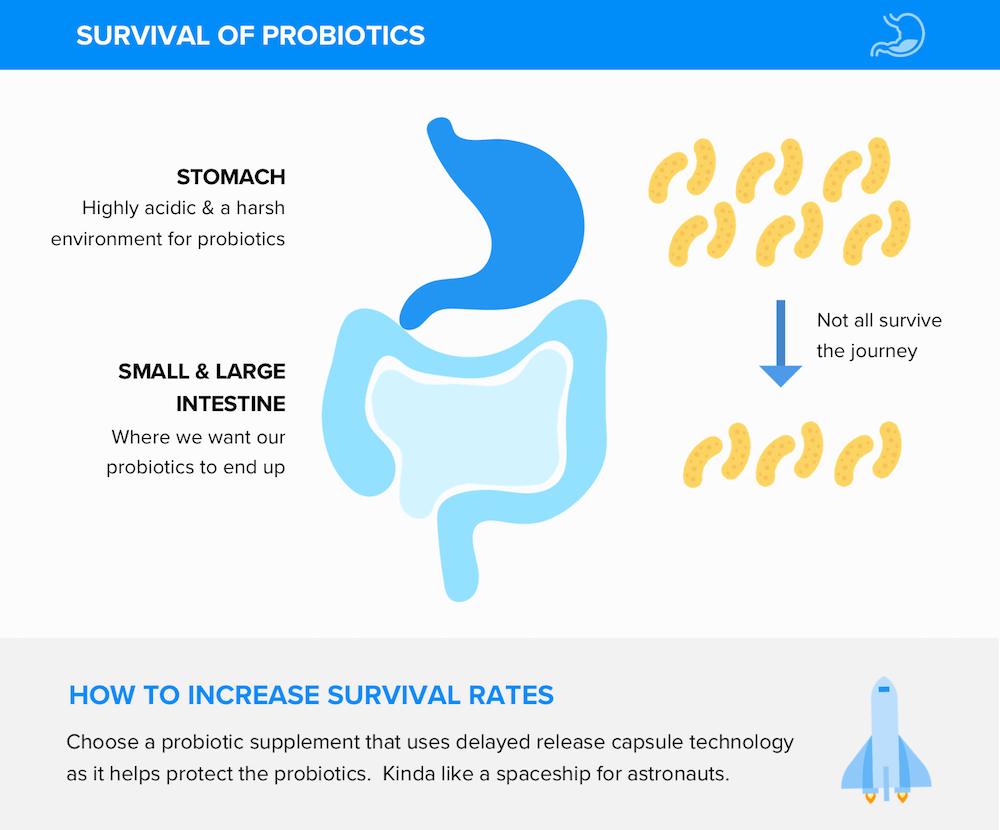Can probiotics help with leaky gut – or do they actually harm it? And what types of probiotics should we really be looking for? We’ll answer all these questions in this ultimate guide to probiotics for leaky gut!
Last Updated: Mar 2, 2024
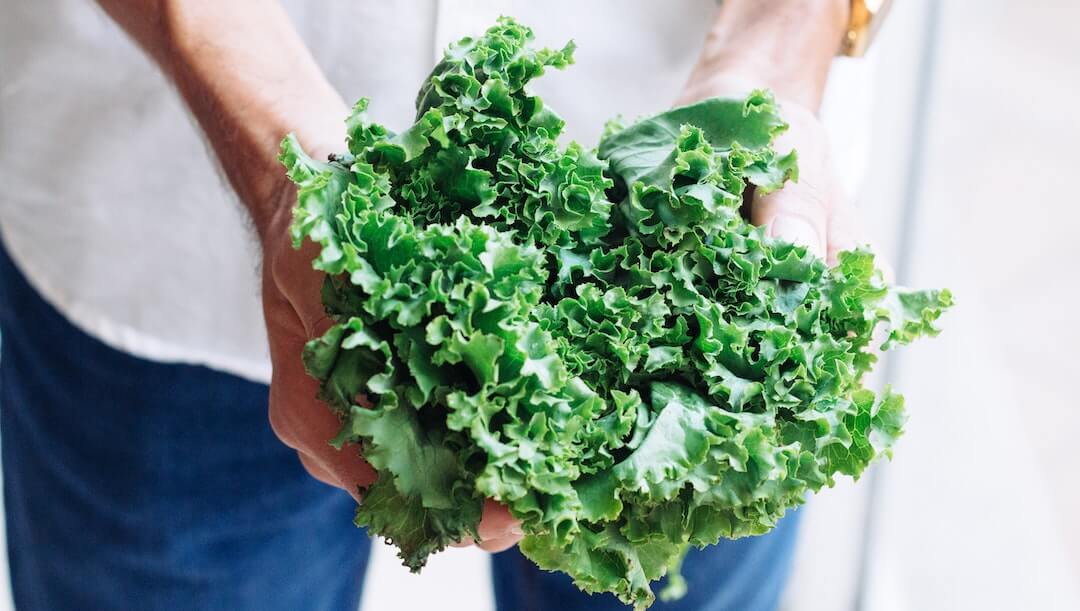
In this guide, you’ll discover…
I take probiotics daily.
When I wake up you might find me taking 1 capsule of this high strength probiotic my research team and I spent 3 months researching & developing.
Then at lunch time I might be tucking into an organic jar of ‘live’ sauerkraut.
And by dinner I might be complementing all that delicious probiotic goodness by eating some prebiotic-rich Jerusalem artichoke (a weird but wonderful vegetable).
This makes me sound like a beanie-wearing hipster, I know. But I don’t care.
You see, the good bacteria from probiotics have proven to be one of the most important supplements/foods I take to keep my gut in good health1.
Which makes sense, especially when we realize our ancestors have been seeking out and consuming lacto-fermented foods to help with digestion for well over a million years . (Before we created fire!)
P.S. probiotics are fantastic, but if you want to discover all of my best ideas for leaky gut, then check out my popular leaky gut recovery guide (PDF).
If you’ve ever tried to Google how probiotics support leaky gut, you’ll no doubt have come across articles so dense in science that it can be impossible to decipher.
Well, I’ve tried to summarize the complicated findings into easy to follow points. As you’ll see, probiotics are phenomenal, especially in terms of theri ability to help support our gut health from so many different angles.
1) Probiotics can support your gut lining’s ‘gatekeepers’ (a.k.a. Tight junctions)
This is very important, because your tight junctions are the guys that decide if something should pass through the intestinal lining (and into your bloodstream) or not2.
When working correctly, tight junctions will allow molecules which are good (hello nutrients) to get through, whilst also ensuring those that are bad (hello undigested large food particles, toxins and food allergens etc) stay out3.
By selectively allowing entry like this you get better nutrient absorption. Which is fantastic.
And by preventing toxins slipping through and into the bloodstream, you help to lower unnecessary immunity responses / inflammation. Even better!
2) Probiotics can prevent bad bacteria and yeast from hanging around
This is a big deal, because if too much bad bacteria and yeast are allowed to hang around, they can increase inflammation and thus leaky gut4. Even better, probiotics can also help with related conditions like SIBO5 and candida6, respectively.
So it’s no wonder that I sometimes think of probiotics like mini Gandalfs (from Lord of the Rings) shuttling around your intestines yelling at bad bacteria “Thou shall not pass!”.
Unsurprisingly probiotics are being used these days to target bad bacteria in other parts of the body too, including your gums (periodontal disease) and they may even help prevent tooth decay as well7.
3) Probiotics can help us break down foods and turn them into nutrients
This is a more indirect digestion aid than say digestive enzymes themselves, but very helpful nonetheless.
For instance, some probiotics can produce exoenzymes that help break down proteins and also help improve the absorption of amino acids in the gut8.
All of this support is very helpful since breaking down our food better will reduce the number of large particles bombarding our poor ol’ intestinal lining.
4) Probiotics have been shown to reduce leaky gut markers!
Best of all, probiotics don’t just sound good on paper. Probiotics actually help to improve the mucosal barrier of the gut thus reducing leaky gut9.
Perhaps the coolest thing about them is that recent studies have shown that markers of intestinal permeability decrease dramatically when probiotics are taken10!
For example, in this randomized, double-blind and placebo-controlled study (Int Soc Sports Nutr 2012), zonulin levels in subjects’ feces were “significantly reduced” after 14 weeks of probiotic use compared to those who didn’t take probiotics.
And since less zonulin means less intestinal permeability, the results indicate probiotics can lead to a healthier intestinal wall.
How can anyone not love these little guys!
3 more ways probiotics work to support your leaky gut
- Probiotics can assist in the secretion of inflammatory mediators11. Which is kinda like organizing your emergency services so they’re all on the same page and not all going around blaring their sirens simultaneously and causing havoc.
- Probiotics can support secretion of additional intestinal mucus (the protective layer for your gut lining/wall12).
- Probiotics can even help control enzyme activities involved in the production of beneficial short chain fatty acids like butyrate13 when fiber is broken down, which your gut absolutely loves since it reduces inflammation in the gut14.
Your security guards, your cheerleaders, your emergency contacts and your best friends…call probiotics what you wish, but these little critters make a BIG difference in improving total gut health for the win!
The answer is ‘it depends’!
You see, whilst others out there will just pick a side and argue it into the ground, I’m a big fan of both probiotic foods and supplements. I see them as extremely complementary.
To help you work out what mix of probiotic foods versus supplements, makes sense, I’ll run through the pros and cons of each, including showing where each one makes the most sense.
Why I love probiotic foods
- Packed with billions of CFUs – most probiotic foods, eg live sauerkraut15, can deliver billions of probiotics with every spoonful. In other words, they can be incredibly potent!
- Some probiotic foods taste amazing – from a delicious (and lightly) Apple-flavored kombucha16 on a hot sunny day to a side of kimchi17 with your roast salmon, probiotic foods can taste insanely good and add incredibly unique flavors to an otherwise forgettable dish.
- Can be pretty convenient – having a few jars of fermented vegetables sitting in the fridge, which I can pick and eat from whenever I like, can be extremely helpful. i.e. they last a long time in your fridge, even after opening, and are perfect for when you’ve run out of normal veg.
My 8 favorite types of probiotic foods
If you really want to enjoy probiotic foods, I recommend you hit up my go tos.
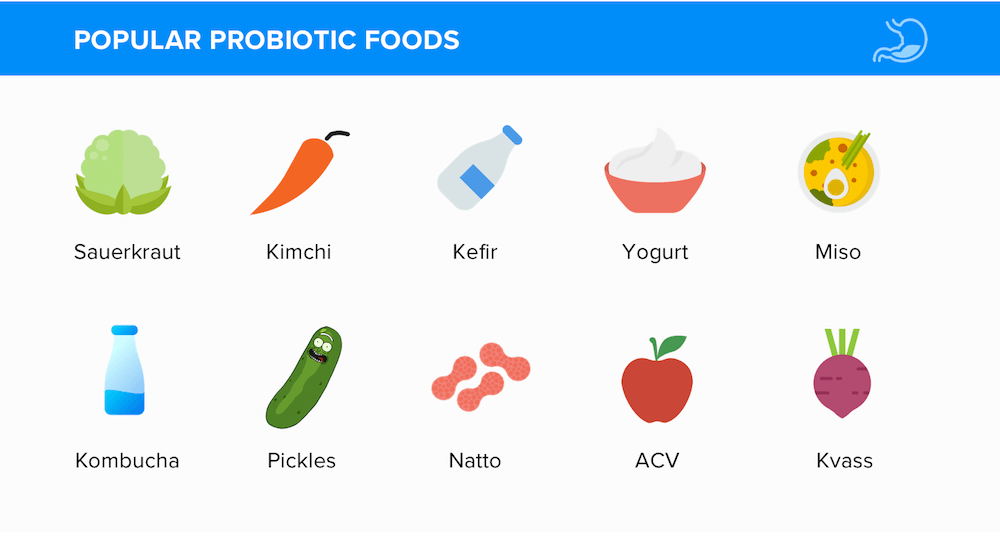
- Kefir – either coconut based, or if you want dairy, then goats milk based kefir18. The tart and sour taste can take some getting used to, but given the high dose probiotics it provides, I’d argue the taste is worth the struggle of adapting to.
- Kombucha – a very refreshing and enjoyable way to get your probiotics each day. The key with kombucha is either making it yourself or finding a store bought one that contains a decent amount of good bacteria, very little net sugar (after fermentation) and not too much sweeteners. Kombucha shouldn’t taste as sweet as your morning OJ – but you’ll grow to appreciate the mix of mildly sweet and tart flavours it has to offer.
- Lightly washed fibrous vegetables – these can be a great source of probiotics, as well as fiber and digestive enzymes. Most of all, with these you enjoy soil-based microorganisms (SBO probiotics), which offer great diversity for your microbiome. Plus the soluble fiber in certain vegetables, eg onions19, Jerusalem artichokes20 etc, helps feed the gut flora (i.e. as prebiotic) – which I explain further below. Just ensure the health of the soil your vegetables come from is good, eg organic farmers, home grown veggie patches (with soil testing) etc, as most probiotics won’t surive in heavily-sprayed fields with poor soil quality.
- Fermented vegetables – I tend to focus most of my probiotic eating on the hero of vegetable fermentation…cabbage21. Whether done German-style (sauerkraut) or Korean style (kimchi), fermented cabbage tastes great with fish, meats and even alongside other vegetables. I also eat pickles (fermented cucumbers) and even some other varieties of kimchi, eg daikon kimchi. Of course, you can ferment just about any vegetable and end up with a jar of bacterial goodness, but the three mentioned above work best in my experience.
The MOST important thing with probiotic foods
Probiotic levels will vary drastically depending on how the foods were made. Factors such as fermentation time, environment sterility, source of ingredients and preservation methods can all influence the amount of beneficial bacteria you’re consuming.
In order to ensure you’re getting a sufficient dose of probiotics, you really need to either make these foods yourself OR buy organic, refrigerated, ‘live’ versions of them.
e.g. Do NOT buy mass produced, shelf-stable sauerkraut for example. It has likely been pasteurized such that all the beneficial bacteria has been destroyed.
Plus these processed versions are usually loaded with other unhealthy, even potentially harmful ingredients from excess sugar to hard-to-pronounce additives.
With all of that said, no amount of probiotic foods in the world will help you if the rest of your diet is bad. As we say in the world of gut health – you can’t out-microbe a poor diet.
So make sure you follow my diet recommendations in this free leaky gut guide.
Why probiotic foods are NOT always ideal
- Low-ish survival rates – many of the strains in probiotic foods are not acid resistant (ie they die off in big numbers when hitting the acidic stomach environment22) and unlike supplements, these bacteria are not protected by an acid resistant outer shell / capsule
- Limited strain diversity – a lot of the foods packing billions of CFUs unfortunately only deliver 1 or a few different strains. For instance, kefir only has about three strains of useful Lactobacillus probiotics23. Since greater bacterial diversity is associated with better overall health, getting a wide variety of strains is key24.
- Easy to get sick of eating – although me and fermented vegetables are good friends, we definitely can get sick of each other! That’s because they come with a very unique and pretty full on flavor profile. After a few nights in a row I often end up needing to take a few days off as the taste memory is so strong. There is only so much fermented cabbage one man can eat!
- Often troublesome foods – many of the sources of probiotic-rich foods are grains, raw vegetables and dairy, which as we know don’t agree with everyone. Issues such as gluten intolerance, low digestive enzyme levels and lactose intolerance are common25, especially those of us on a leaky gut diet, and cause significant digestive distress. You can mitigate this somewhat by going for raw cultured dairy like yogurt and cheese, but digestive symptoms can still vary from person to person.
- Added sugar and sweeteners – I see a lot of products like kombucha, yogurts etc, that come loaded with flavorings to make them taste good and to take off the natural sour flavor profile that tends to come with fermented products. Although some of this sugar gets eaten up during fermentation, you can still be left with a lot more than any leaky gutter ought to be eating. It’s important to remember that excess sugar consumption can lead to dysbiosis and even make leaky gut worse26! Definitely the opposite effect you want to achieve from these probiotic foods.
- Hard to make – a lot of people complain to me that they struggle to follow fermenting recipes and get crazy confused with all the different steps needed. You need to be very careful when it comes to factors such as bacterial sanitation, optimal temperatures and fermentation times – which can feel like a challenge outside of a science lab!
- Hard to access/buy – foods with real, live probiotics in them are usually only found in your local health food or Wholefood store. Although, this is changing as more shelf stable strains are used in more mainstream products, it still limits both accessibility and portability as these foods often require refrigeration.
- Expensive to buy – I’m sure if you’ve bought a few bottles of kombucha or kefir, or even jars of real live sauerkraut (hint: it is always refrigerated), then you’ll know it can be frightfully expensive, eg $15 for a 4-6 serving jar of sauerkraut, $4 for a small bottle of kombucha etc. If you’re not careful your probiotic bill could end up costing triple digits in a quite week!
Why I love probiotic supplements
As you can see from above there are quite a few drawbacks with probiotic foods. No wonder most people, including myself often, don’t eat probiotic foods every single day.
To help us get a steady dose of probiotics each day, a good quality probiotic supplement can be a game changer. That’s because probiotic supplements have a long list of advantages over probiotic foods, such as …
- High survival rates – thanks to smart strain selection (eg acid resistant strains) and protective encapsulation technology (eg DR caps), probiotic supplements can do a great job at bypassing the stomach and getting to where they’re needed.
- Strain diversity – broad spectrum probiotic formulas usually offer 10-12 different strains of good bacteria in every capsule. And since each strain offers a host of different benefits, this can help our guts from various angles.
- Flavorless, odorless – probiotic supplements, especially those in capsule form, usually have very little flavor or odor, making them easy to take every day. i.e. unlike sour sauerkraut for example, you won’t get ‘sick’ of taking a supplement form of probiotics.
- Easy to get – you can pick up quality supplements from a host of trusted producers and even have them delivered right to your door!
- Relatively inexpensive – although a bottle of high quality probiotics with 50 billion CFUs will often run $25-$40, it usually works out to around $1 a day. Compared to a $4 bottle of kombucha packing less good bacteria and less strain diversity, it is a bargain!
- So easy to take – taking less than 10 seconds out of our day to swallow 1 capsule of probiotics can sure beat trying to shovel forkfuls of kimchi in our mouth every time we sit down to lunch.
- Easy to store and travel with – unlike probiotic foods, probiotic supplements can be formulated to be shelf stable. ie no need to keep them constantly refrigerated. This means we can keep them on our desk at work or even travel with them on holidays. Extreme convenience.
So as you can see I love high quality, premium probiotic supplements. And, in return, my gut loves me for taking them!
And if you want the same one I take – the one my research team and I spent months formulating – you can get our high strength probiotic supplement here.
Probiotic foods versus supplements – how to work out when each makes sense
As you can see from the graphic immediately below, probiotic foods are great if you have the time to make them or the money to buy the live versions of them.
And of course, they work best when you consume a wide variety of them so that you get a diversity of good bacteria strains – which, as mentioned earlier, is linked to better overall health27.
The other key is actually enjoying the unique flavor of probiotic foods and being able to consume them frequently, eg several times a week, or ideally on a daily basis.
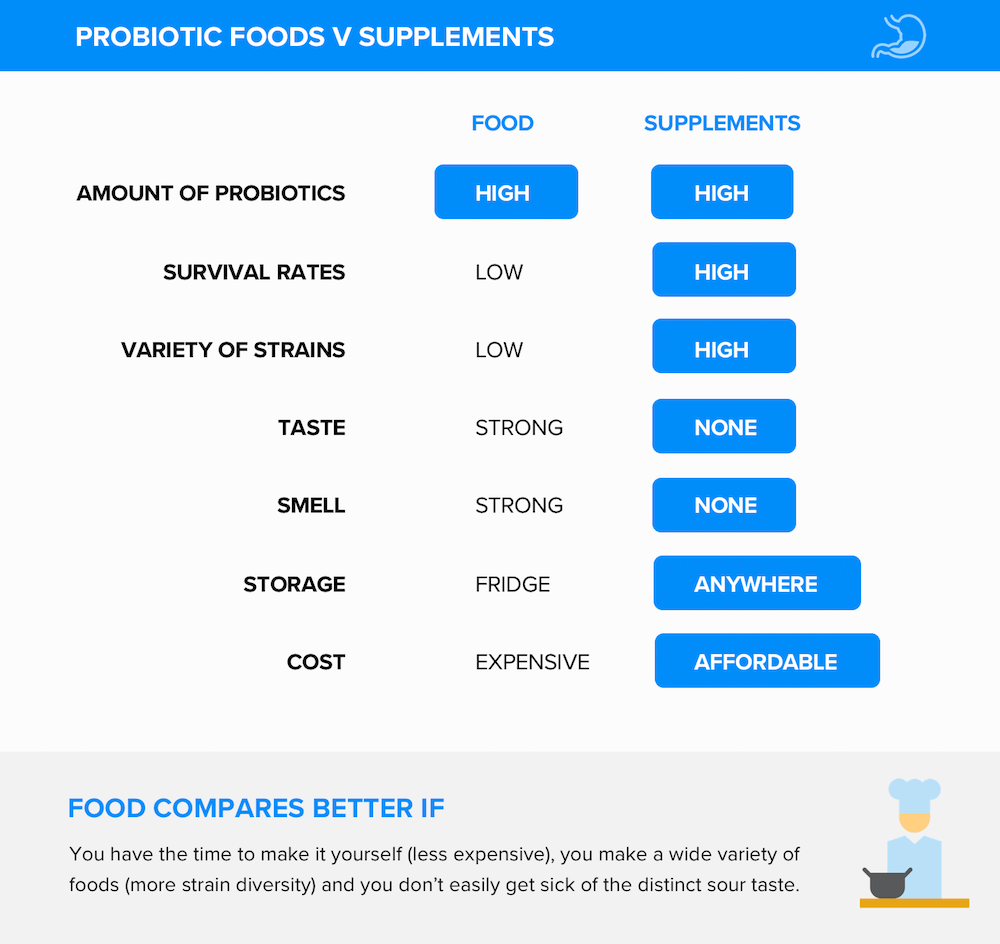
For a lot of people these requirements are hard to take or there are otherwise periods in our lives when we just don’t have the discipline to eat our probiotic foods like a fermenting-crazed Popeye!
And in situations like that, probiotic supplements are the ultimate way to go.
If you choose a smartly formulated probiotic supplement, you’ll enjoy a…
- Powerful dose of good bacteria – eg 50 billion CFUs of good bacteria per capsule
- Broad diversity of probiotic strains – eg 10-12, not just 2-3
- Technology that can enhance the survivial rates of your probiotic warriors – eg delayed release capsules, which protect the probiotics in their journey through your acidic stomach
- No flavor, no smell experience – the easiest way to consumer probiotics!
- Super convenient storage solution – ie a bottle of probiotics that can sit on your desk, is much easier than a big jar of sauerkraut that needs to always be in the fridge at home
- Quite affordable source of probiotics – with most supplements costing less than $1 a day.
- Maybe even more importantly, they’re so easy – nothing to make, nothing to sit down to eat. Just take 1 capsule from a bottle and drink it down.
When you consider all the benefits and ease that can be achieved for around $1 per day compared to pricier probiotic foods – there’s really no question as to why I’ve chosen probiotics as the best option for myself.
Unlike a lot of other supplements that can cause problems when over doing them, it’s somewhat hard to take too much probiotics.
That said, you can experience some digestive symptoms (gas, rumblings, cramping) when you first start taking probiotics or megadose them (ie 100 billion or higher28).
The good news is that in most cases this is actually a sign the probiotics are working…
…you see, during the first week or two of use, the good bacteria will be swan diving into your system and hopefully kicking the bad bacteria’s ass. In doing so, a lot of the bad bacteria will die, as the bacteria in the gut are in competition with each other29 – and the good bacteria are kicking some serious buttocks! And this is known as ‘die off’.
And whilst your body is detoxing itself from all the dead bad bacteria (and yeast) in your system you’ll likely feel it!
Choosing the right amount of probiotics to take
As with most things leaky gut related, the probiotic dosage recommendations out there vary widely – and be quite confusing.
But here’s the thing: it is impossible to give a blanket statement until we cover a few points of distinction.
Unsurprisingly, most people never mention these points as they require deeper level thinking, but they are very important. The goals you personally want to achieve from taking probiotics and the quality of supplements you choose can really make all of the difference.
And as with everything, speak to your healthcare professional to work out what makes sense for you personally.
It depends on why you’re taking them and the quality of the supplement you choose
1) Depends on the reason you’re taking probiotics
Initial dose v long term dose
During the first 2-4 weeks of use (ie just starting a leaky gut recovery protocol) I would work up to a high dose. That’s because at this point my gut’s bacteria balance is likely out of whack and in proper need of the good guys.
Anywhere between 75-100 billion a day, with half in morning and half before going to bed, would sit in the sweet spot during this time.
Of course, I would test out a smaller dose in the first few days, just to check my body agrees with the particular probiotic.
Then long term I would be happy with 50 billion CFUs a day, which I’ll explain below
Defense dose
I also go with a higher and more frequent dose of probiotics during times when my good bacteria is being wiped out.
eg if I am using antibiotics, NSAIDs, steroids (eg for asthma), acid blockers, enjoying some good ol’ food poisoning / diarrhea etc. then a higher dose of probiotics can be necessary to replenish the good bacteria that’s being lost.
As an example – when taking antibiotics I’ll typically take 100 billion CFUs of probiotics a day. Antibiotic therapy often leads to gut dysbiosis in which bacteria in the gut are disrupted30, so it’s a pretty good idea to use probiotics alongside of them.
Obviously, I’d check with my doctor to ensure probiotics are compatible with my specific treatment. But, once again, this sort of escalation of dose is only temporary and can typically be reduced shortly after antibiotic therapy is completed.
Extra support dose
I might also up the dose from my normal long term dose of 50 billion CFUs, during times when my good bacteria is at risk of pathogenic invasion or other unfamiliar threats.
eg when traveling, drinking highly chlorinated water or even when drinking a wee bit too much alcohol (hello New Years Eve my old friend).
These can all threaten your gut flora, so upping your normal support dose during these times could be worthwhile. Around the 75 billion CFUs mark can really offer a lot of extra help during these times.
2) Depends on the quality of the probiotic supplement you choose
Quality & quantity of probiotic strains used
Probiotic strains (eg L Plantarum) vary greatly in terms of how they help and how much is needed of each of them to do their thing.
Unfortunately, most popular brands tend to offer only a few strains (eg 1-4) and usually the cheaper ones.
And, remember how we discussed the link between greater bacterial diversity and better overall gut health? Well, when it comes to maximizing the health of your gut bacteria, 1-4 strains just doesn’t cut it.
Instead, you should be looking for a supplement with closer to 10-12 strains, as this will offer you a nice wide range of benefits. Importantly, look for your favorite strains towards the beginning of the formula, as those strains appear in the highest amounts in the formula.
i.e. to sum all of this up – there is a huge difference between a 50 billion CFUs probiotic with just L Acidophilus versus a 50 billion CFUs probiotic with 10 different premium strains.
Presence of prebiotic
Having good quality prebiotics such as inulin or Jerusalem artichoke in your probiotic can help feed your probiotics. Kinda like the way fuel tanks work with a spaceship.
i.e. armed with a prebiotic, you could potentially achieve more benefits and increase the efficacy of your probiotic, without increasing the number of CFUs it contains.
With that said, you should not rely on the prebiotic in your probiotic alone for this. Instead, make sure your diet is high in prebiotic foods as well, and consider a dedicated, high quality prebiotic supplement like this one, which I’ll discuss further below.
Delayed release capsules, aka enteric coated or DR caps
These can be a total game changer for working out how much probiotics to take.
That’s because DR caps offer your probiotics protection as they pass through the fiery passageway of your stomach, in order to increase activity and survival. And thus, DR caps can help more of the probiotics reach your intestines where they can get to work!
Without this DR tech you can lose billions of probiotics in the harsh stomach environment, and thus would need to take a much higher dose to achieve any benefits.
My favorite amount of probiotics to take long term
When weighing up everything above, it becomes pretty clear that for those of us with a history of poor gut health (eg leaky gut), that 50 billion CFUs is the sweet spot for long term use.
i.e. enough to have an impact on our gut flora and support an optimal balance of good to bad bacteria, but not so much that we are drowning ourselves in a surplus of unnecessary CFUs.
Importantly though, these CFUs need to come from a high quality probiotic supplement – which as you’ve learned above means one with 10-12 different premium probiotic strains (eg L Rhamnosus, L Plantarum, B Bifidum etc), a prebiotic component and delayed release capsule technology.
That way, not only are we getting the right amount of probiotics CFUs, but we’re also getting them in the right form and ensuring our helpful little friends are delivered to where we need them most (our beautiful intestines).
P.S. to save you any guesswork, I will run through my 7 favorite strains further below.
Simple. Take them in the morning when you wake up and just before you eat breakfast.
Here’s why…
…in a 2011 study (Benef Microbes. 2011 Dec 1;2(4):295-303) a team of Canadian researchers actually built an end-to-end fake digestive tract, complete with a fake stomach and intestines.
But of course, they used real acid, enzymes, bile etc to mimic the human experience.
They then fed the mock digestive system a multi-strain probiotic containing 4 very popular strains – Lactobacillus helveticus (R0052), Lactobacillus rhamnosus (R0011), Bifidobacterium longum (R0175) and Saccharomyces cerevisiae.
This was done before, during and after meals.
The team found survival rates were highest when the probiotic was taken between 30 minutes and just when starting a meal.
Conversely, they found probiotics did not survive in high numbers when the supplement was taken 30 minutes AFTER a meal.
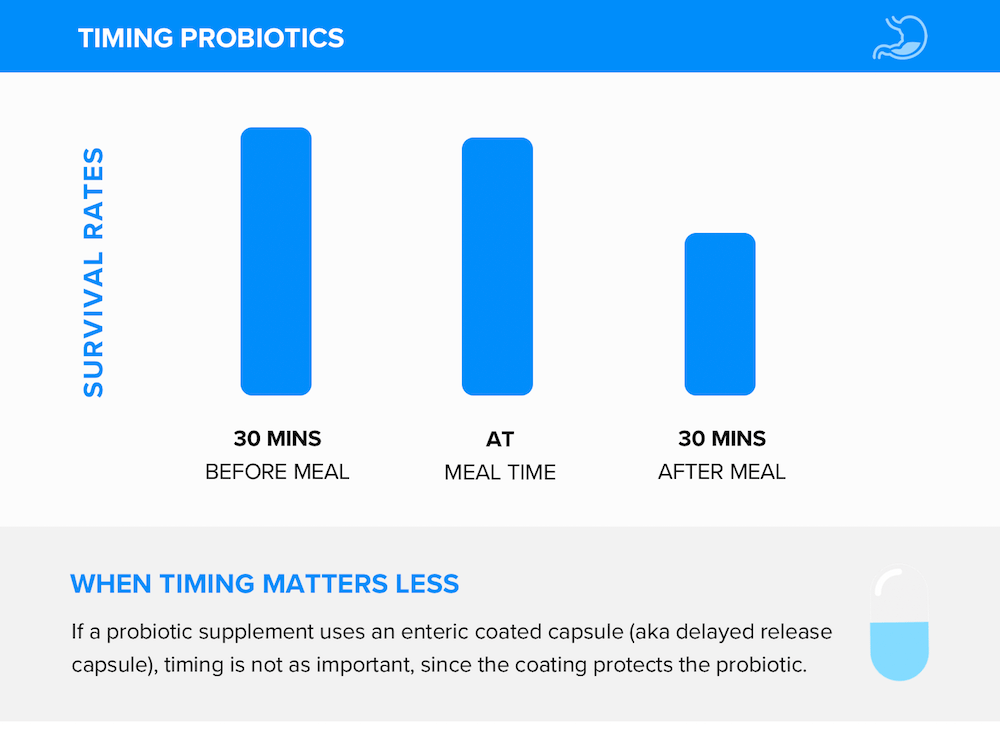
(Note on graphic: this is a rough approximation after averaging results from the tests done on all 4 strains and across different liquid/food intakes).
One last interesting finding was that survival rates were highest when the meal eaten contained some fat. Not a crazy amount, but some fat helped. eg in their experiment 1% fat milk was used and contrasted against fruit juice and plain water.
If you’re interested, you can read the 10-page report on probiotic timing with meals here.
So based on this actual study of probiotic survival rates I like to take my probiotic at 6am, which is just when I wake up and usually eat my breakfast.
i.e. I take my probiotic when I wake up and then a few minutes later I crawl into the kitchen and rummage around my fridge for a light meal with some fats (hello avocado my good friend!).
Meanwhile, if you are taking a higher than normal dose of probiotics, eg 100 billion CFUs a day, then consider splitting it up, so you take half before breakfast and the other half just before dinner.
Of course, timing is less important if you are taking a probiotic with delayed release capsules (DR caps).
That’s because they use an enteric coating on the capsules to protect the probiotics and help increase their chances of getting to where they’re needed. (Kinda like a spaceship for astronauts, which I’ll explain below).
Probiotics with delayed release capsules are obviously more convenient, since you can take them whenever you feel like.
Sometimes life can get busy and between work, friends, family and trying to maintain our health – timing our probiotics isn’t always our #1 priority.
And that’s exactly why my company formulates our 50 billion CFUs probiotic with high-quality, reliable DR caps that allow your probiotics to suit your lifestyle – and not the other way around.
Importantly, make sure you consume prebiotics and probiotics in food form during the day too. These will play an important role in making sure probiotics get down to where they’re needed and can work their magic in your gut!
I talked about the probiotic-rich foods I eat above.
As for prebiotic rich foods, I try to eat garlic, leek, onion and where possible chicory root31. But more often I go to green bananas, as they are low in FODMAPs (a.k.a. fermentable sugars), so arguably more ideal for sensitive guts like ours32.
Green bananas in particular carry the added benefit of being a source of good resistant starch (RS)33, which works really well to make sure the bacteria in the colon are in good health as well34.
Bananas convert more of this starch into sugar as they ripen, therefore increasing their FODMAP levels26. So, a good rule of thumb for bananas is – the greener the greater!
Resistant starch is easy to find in foods and can provide great prebiotic support for your probiotics to survive and thrive! In fact, there is growing research on the interplay of resistant starch with probiotics, and your gut flora in general with RS showing to increase populations of good good bacteria, such as bifidoacteria, within the gut35.
Probably the simplest way to get prebiotics is through a low FODMAP prebiotic powder. You definitely want to ease into this though.
Don’t megadose! Do the opposite.
As it can be fairly tough on your system when you first take it and – just like any dietary fiber increase, you want to do this gradually to give your body the time and space it needs to adjust. A slow increase of a couple of grams per week is more than enough to achieve the benefits your bacteria want and need!
Lastly, I just want to reiterate that probiotic and prebiotic foods/supplements are best taken after you’ve been working on healing your gut for 2-3 weeks; ie clean diet, L-Glutamine, digestive enzymes etc. All the things I advise in my free leaky gut recovery guide.
Because only at this point will your gut be really be primed for the effects of probiotics/prebiotics, as discussed at the start of this article.
Unlike a lot of other supplements that you might only use for a short period, eg anti-fungals for candida, or you might cycle on and off, eg vitamin D in summer, I take probiotics every day.
The reason I do is to help to maintain my gut health, keep inflammation at bay and ensure leaky gut doesn’t come back.
The good news is that you shouldn’t need to megadose probiotic supplements to help maintain a healthy balance of good vs bad bacteria. Instead, simply taking the recommended dose of probiotics (on the label), paired with probiotic-rich foods, will help do the job.
As you’ll see from the dose comments above, I recommend you take a high potency probiotic with a prebiotic component included (eg FOS, inulin etc).
Obviously make sure it is not a generic brand or cheap product – or else you may not be achieving the benefits of supplementing, or even be consuming artificial additives and fillers that could actually harm your gut health!
In addition, you should be looking for a multi-strain probiotic. Importantly, more is not always better.
You see, too many different beneficial bacteria in one probiotic supplement could end up in a bacteria battle royale! This happens when there are too many types and the bacteria end up competing with each other before they can each find their own home in your system.
As with everything in life – balance is key! So I recommend you look for a product with around 10-12 strains
The 2 most important groups of bacteria are Lactobacillus and Bifidobacterium36. So making sure you choose a product with strains from these 2 groups is crucial, eg L Acidophilus.
Importantly, look for a probiotic containing my 7 favorite strains: L Plantarum37, L Rhamnosus38, L Acidophilus39, B Bifidum40, B Longum41, B Lactis42 and B Coagulans43.
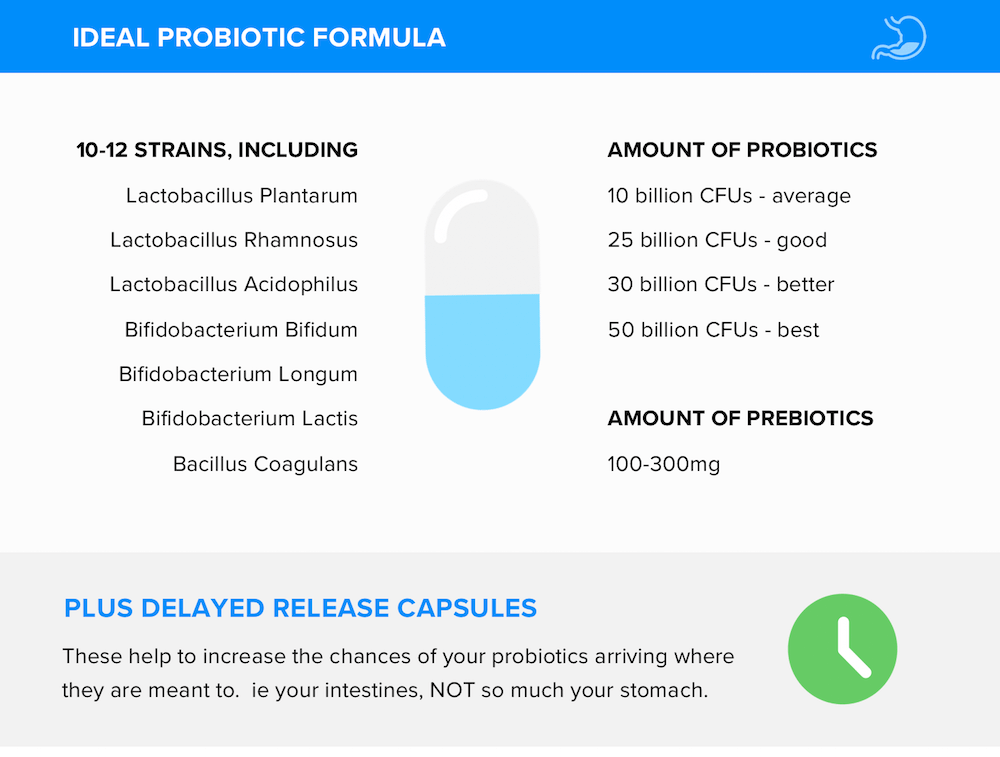
Which probiotic meets all of the points above?
Well, after receiving hundreds of requests from Goodbye Leaky Gut readers, my research team and I decided to develop a next generation probiotic-prebiotic complex that ticks all the boxes above.
And the good news is that after months of research and development our probiotic is available here.
It is the exact probiotic formulation I’ve always been looking for, because it is strong enough to meet our requirements (50 billion CFUs), has 11 different high quality strains, contains 2 premium prebiotics, and uses delayed release capsule technology to help the probiotics survive the journey.
This combination means you get your probiotics delivered to the place where they’re actually required (ie your gut). And this optimal delivery process makes all the difference.
With these probiotics, you’re getting all of the requirements to maximize the efficacy of your probiotics in one, single, easy-to-take capsule.
No more carrying around a jar of probiotic sauerkraut while snacking on a prebiotic onion – just one, single capsule that delivers everything you need in under 10 seconds a day.
You can purchase this probiotic here on Amazon.
References
- La Fata G, Weber P, Mohajeri MH. Probiotics and the gut immune system: indirect regulation. Probiotics and antimicrobial proteins. 2018 Mar 1;10(1):11-21.2.
- Lee B, Moon KM, Kim CY. Tight junction in the intestinal epithelium: Its association with diseases and regulation by phytochemicals. Journal of immunology research. 2018;2018.
- Yu LC. Intestinal epithelial barrier dysfunction in food hypersensitivity. Journal of allergy. 2012;2012.
- 2. Lee B, Moon KM, Kim CY. Tight junction in the intestinal epithelium: Its association with diseases and regulation by phytochemicals. Journal of immunology research. 2018;2018.
- Zhong C, Qu C, Wang B, Liang S, Zeng B. Probiotics for Preventing and Treating Small Intestinal Bacterial Overgrowth. Journal of clinical gastroenterology. 2017 Apr 1;51(4):300-11.
- Superti F, De Seta F. Warding Off Recurrent Yeast and Bacterial Vaginal Infections: Lactoferrin and Lactobacilli. Microorganisms. 2020 Jan;8(1):130.
- Gruner D, Paris S, Schwendicke F. Probiotics for managing caries and periodontitis: systematic review and meta-analysis. Journal of dentistry. 2016 May 1;48:16-25.
- Wang J, Ji H. Influence of Probiotics on Dietary Protein Digestion and Utilization in the Gastrointestinal Tract. Current Protein and Peptide Science. 2019 Feb 1;20(2):125-31.
- Persborn M, Gerritsen J, Wallon C, Carlsson A, Akkermans LM, Söderholm JD. The effects of probiotics on barrier function and mucosal pouch microbiota during maintenance treatment for severe pouchitis in patients with ulcerative colitis. Alimentary pharmacology & therapeutics. 2013 Oct;38(7):772-83.
- Persborn M, Gerritsen J, Wallon C, Carlsson A, Akkermans LM, Söderholm JD. The effects of probiotics on barrier function and mucosal pouch microbiota during maintenance treatment for severe pouchitis in patients with ulcerative colitis. Alimentary pharmacology & therapeutics. 2013 Oct;38(7):772-83.
- De Santis S, Cavalcanti E, Mastronardi M, Jirillo E, Chieppa M. Nutritional keys for intestinal barrier modulation. Frontiers in immunology. 2015 Dec 7;6:612.
- De Santis S, Cavalcanti E, Mastronardi M, Jirillo E, Chieppa M. Nutritional keys for intestinal barrier modulation. Frontiers in immunology. 2015 Dec 7;6:612.
- Plaza-Diaz J, Ruiz-Ojeda FJ, Gil-Campos M, Gil A. Mechanisms of action of probiotics. Advances in Nutrition. 2019 Jan 1;10(suppl_1):S49-66.
- Scheppach W, Müller JG, Boxberger F, Dusel G, Richter F, Bartram HP, Christl SU, Dempfle CE, Kasper H. Histological changes in the colonic mucosa following irrigation with short-chain fatty acids. European journal of gastroenterology & hepatology. 1997 Feb;9(2):163-8.
- Yu Z, Zhang X, Li S, Li C, Li D, Yang Z. Evaluation of probiotic properties of Lactobacillus plantarum strains isolated from Chinese sauerkraut. World Journal of Microbiology and Biotechnology. 2013 Mar 1;29(3):489-98.
- Liu Y, Tran DQ, Rhoads JM. Probiotics in disease prevention and treatment. The Journal of Clinical Pharmacology. 2018 Oct;58:S164-79.
- Liu Y, Tran DQ, Rhoads JM. Probiotics in disease prevention and treatment. The Journal of Clinical Pharmacology. 2018 Oct;58:S164-79.
- Heller KJ. Probiotic bacteria in fermented foods: product characteristics and starter organisms. The American journal of clinical nutrition. 2001 Feb 1;73(2):374s-9s.
- Holscher HD. Dietary fiber and prebiotics and the gastrointestinal microbiota. Gut microbes. 2017 Mar 4;8(2):172-84.
- Dimitrovski D, Velickova E, Dimitrovska M, Langerholc T, Winkelhausen E. Synbiotic functional drink from Jerusalem artichoke juice fermented by probiotic Lactobacillus plantarum PCS26. Journal of food science and technology. 2016 Jan 1;53(1):766-74.
- Swain MR, Anandharaj M, Ray RC, Parveen Rani R. Fermented fruits and vegetables of Asia: a potential source of probiotics. Biotechnology research international. 2014;2014.
- Talib N, Mohamad NE, Yeap SK, Hussin Y, Aziz MN, Masarudin MJ, Sharifuddin SA, Hui YW, Ho CL, Alitheen NB. Isolation and Characterization of Lactobacillus spp. from Kefir Samples in Malaysia. Molecules. 2019 Jan;24(14):2606.
- Talib N, Mohamad NE, Yeap SK, Hussin Y, Aziz MN, Masarudin MJ, Sharifuddin SA, Hui YW, Ho CL, Alitheen NB. Isolation and Characterization of Lactobacillus spp. from Kefir Samples in Malaysia. Molecules. 2019 Jan;24(14):2606.
- Milani C, Duranti S, Bottacini F, Casey E, Turroni F, Mahony J, Belzer C, Palacio SD, Montes SA, Mancabelli L, Lugli GA. The first microbial colonizers of the human gut: composition, activities, and health implications of the infant gut microbiota. Microbiol. Mol. Biol. Rev.. 2017 Dec 1;81(4):e00036-17.
- Lomer MC, Parkes GC, Sanderson JD. lactose intolerance in clinical practice–myths and realities. Alimentary pharmacology & therapeutics. 2008 Jan;27(2):93-103.
- Rinninella E, Cintoni M, Raoul P, Lopetuso LR, Scaldaferri F, Pulcini G, Miggiano GA, Gasbarrini A, Mele MC. Food components and dietary habits: Keys for a healthy gut microbiota composition. Nutrients. 2019 Oct;11(10):2393.
- Milani C, Duranti S, Bottacini F, Casey E, Turroni F, Mahony J, Belzer C, Palacio SD, Montes SA, Mancabelli L, Lugli GA. The first microbial colonizers of the human gut: composition, activities, and health implications of the infant gut microbiota. Microbiol. Mol. Biol. Rev.. 2017 Dec 1;81(4):e00036-17.
- Parkes GC, Sanderson JD, Whelan K. Treating irritable bowel syndrome with probiotics: the evidence. Proceedings of the Nutrition Society. 2010 May;69(2):187-94.
- Kamada N, Seo SU, Chen GY, Núñez G. Role of the gut microbiota in immunity and inflammatory disease. Nature Reviews Immunology. 2013 May;13(5):321-35.
- Holota Y, Dovbynchuk T, Kaji I, Vareniuk I, Dzyubenko N, Chervinska T, Zakordonets L, Stetska V, Ostapchenko L, Serhiychuk T, Tolstanova G. The long-term consequences of antibiotic therapy: Role of colonic short-chain fatty acids (SCFA) system and intestinal barrier integrity. PloS one. 2019;14(8).
- Carlson JL, Erickson JM, Lloyd BB, Slavin JL. Health effects and sources of prebiotic dietary fiber. Current developments in nutrition. 2018 Mar 1;2(3):nzy005.
- Cordenunsi-Lysenko BR, Nascimento JR, Castro-Alves VC, Purgatto E, Fabi JP, Peroni-Okyta FH. The starch is (not) just another brick in the wall: The primary metabolism of sugars during banana ripening. Frontiers in plant science. 2019;10.
- Cordenunsi-Lysenko BR, Nascimento JR, Castro-Alves VC, Purgatto E, Fabi JP, Peroni-Okyta FH. The starch is (not) just another brick in the wall: The primary metabolism of sugars during banana ripening. Frontiers in plant science. 2019;10.
- Walker AW, Ince J, Duncan SH, Webster LM, Holtrop G, Ze X, Brown D, Stares MD, Scott P, Bergerat A, Louis P. Dominant and diet-responsive groups of bacteria within the human colonic microbiota. The ISME journal. 2011 Feb;5(2):220-30.
- Zheng Y, Wang Q, Li B, Lin L, Tundis R, Loizzo MR, Zheng B, Xiao J. Characterization and prebiotic effect of the resistant starch from purple sweet potato. Molecules. 2016 Jul;21(7):932.
- Feng Y, Duan Y, Xu Z, Lyu N, Liu F, Liang S, Zhu B. An examination of data from the American Gut Project reveals that the dominance of the genus Bifidobacterium is associated with the diversity and robustness of the gut microbiota. MicrobiologyOpen. 2019 Dec;8(12):e939.
- Khalil ES, Manap A, Yazid M, Mustafa S, Alhelli AM, Shokryazdan P. Probiotic properties of exopolysaccharide-producing Lactobacillus strains isolated from Tempoyak. Molecules. 2018 Feb;23(2):398.
- Good, M., Sodhi, C.P., Ozolek, J.A., Buck, R.H., Goehring, K.C., Thomas, D.L., Vikram, A., Bibby, K., Morowitz, M.J., Firek, B. and Lu, P., 2014. Lactobacillus rhamnosus HN001 decreases the severity of necrotizing enterocolitis in neonatal mice and preterm piglets: evidence in mice for a role of TLR9. American Journal of Physiology-Gastrointestinal and Liver Physiology, 306(11), pp.G1021-G1032.
- Alamdary SZ, Bakhshi B, Soudi S. The anti-apoptotic and anti-inflammatory effect of Lactobacillus acidophilus on Shigella sonnei and Vibrio cholerae interaction with intestinal epithelial cells: A comparison between invasive and non-invasive bacteria. PloS one. 2018;13(6).
- Duranti S, Vivo V, Zini I, Milani C, Mangifesta M, Anzalone R, Mancabelli L, Viappiani A, Cantoni AM, Barocelli E, van Sinderen D. Bifidobacterium bifidum PRL2010 alleviates intestinal ischemia/reperfusion injury. PloS one. 2018;13(8).
- McCarville JL, Dong J, Caminero A, Bermudez-Brito M, Jury J, Murray JA, Duboux S, Steinmann M, Delley M, Tangyu M, Langella P. A commensal Bifidobacterium longum strain prevents gluten-related immunopathology in mice through expression of a serine protease inhibitor. Appl. Environ. Microbiol.. 2017 Oct 1;83(19):e01323-17.
- Burns P, Alard J, Hrdỳ J, Boutillier D, Páez R, Reinheimer J, Pot B, Vinderola G, Grangette C. Spray-drying process preserves the protective capacity of a breast milk-derived Bifidobacterium lactis strain on acute and chronic colitis in mice. Scientific reports. 2017 Feb 24;7:43211.
- Wu Y, Shao Y, Song B, Zhen W, Wang Z, Guo Y, Shahid MS, Nie W. Effects of Bacillus coagulans supplementation on the growth performance and gut health of broiler chickens with Clostridium perfringens-induced necrotic enteritis. Journal of animal science and biotechnology. 2018 Dec;9(1):9

